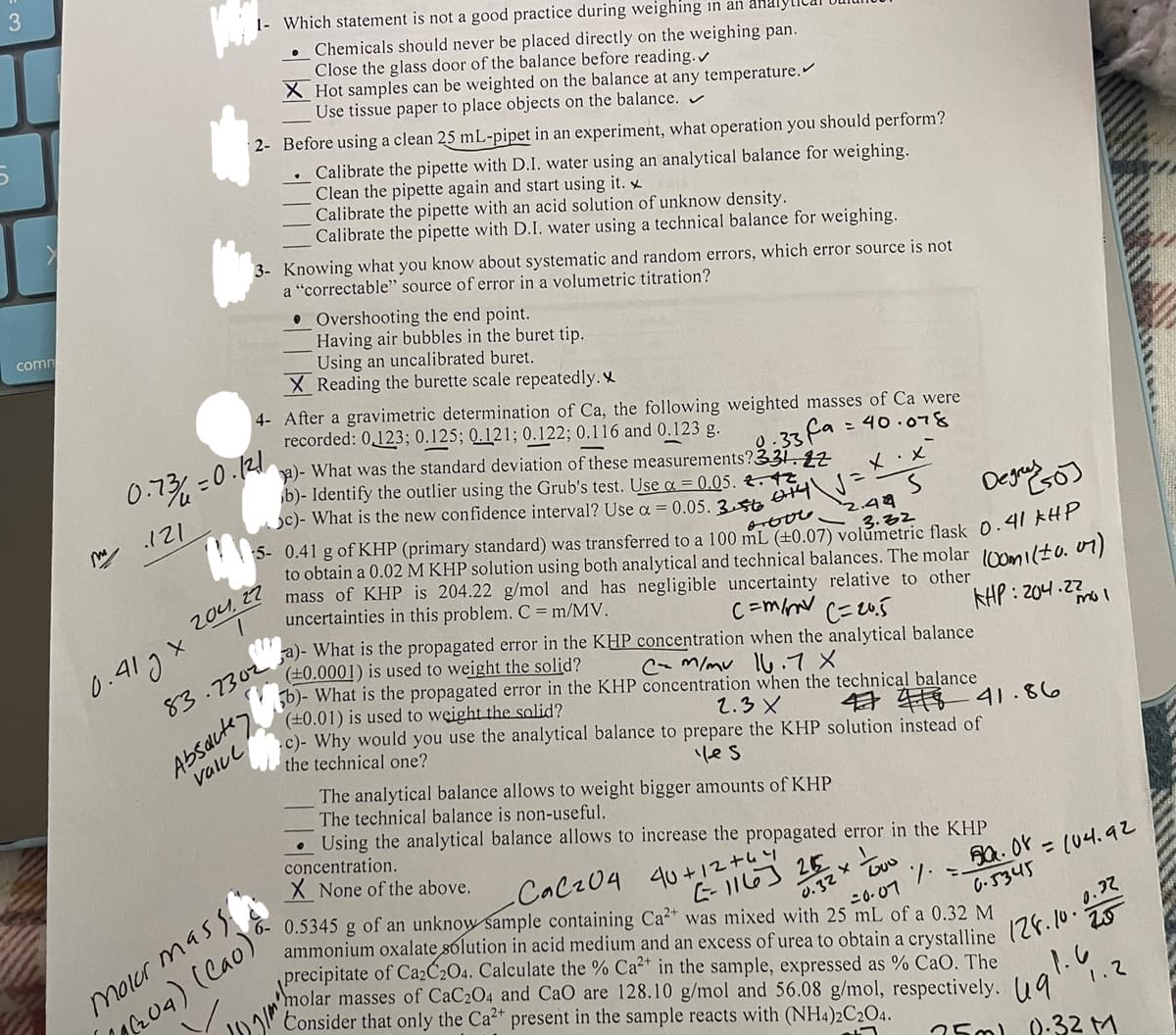1- Which statement is not a good practice during weighing in Chemicals should never be placed directly on the weighing pan. Close the glass door of the balance before reading. X Hot samples can be weighted on the balance at any temperature. Use tissue paper to place objects on the balance. u chould nerform?
1- Which statement is not a good practice during weighing in Chemicals should never be placed directly on the weighing pan. Close the glass door of the balance before reading. X Hot samples can be weighted on the balance at any temperature. Use tissue paper to place objects on the balance. u chould nerform?
Principles of Instrumental Analysis
7th Edition
ISBN:9781305577213
Author:Douglas A. Skoog, F. James Holler, Stanley R. Crouch
Publisher:Douglas A. Skoog, F. James Holler, Stanley R. Crouch
Chapter33: Automated Methods Of Analysis
Section: Chapter Questions
Problem 33.8QAP
Related questions
Question
Need question 1,2,3

Transcribed Image Text:1- Which statement is not a good practice during weighing in an analyl
Chemicals should never be placed directly on the weighing pan.
Close the glass door of the balance before reading.
X Hot samples can be weighted on the balance at any temperature.
Use tissue paper to place objects on the balance.
2- Before using a clean 25 mL-pipet in an experiment, what operation you should perform?
Calibrate the pipette with D.I. water using an analytical balance for weighing.
Clean the pipette again and start using it.
Calibrate the pipette with an acid solution of unknow density.
Calibrate the pipette with D.I. water using a technical balance for weighing.
3- Knowing what you know about systematic and random errors, which error source is not
a "correctable" source of error in a volumetric titration?
• Overshooting the end point.
Having air bubbles in the buret tip.
Using an uncalibrated buret.
X Reading the burette scale repeatedly. X
comm
4- After a gravimetric determination of Ca, the following weighted masses of Ca were
recorded: 0,123; 0.125; Q.121; 0.122; 0.116 and 0.123 g.
a)- What was the standard deviation of these measurements?331,97
b)- Identify the outlier using the Grub's test. Use a = 0.05. &. t
c)- What is the new confidence interval? Use a = 0.05. 35t0
0.73=0.121
0.33fa = 40.078
X.メ
Dego so)
.121
5- 0.41 g of KHP (primary standard) was transferred to a 100 mL (+0.07) volumetric flask 0.41 Fn
to obtain a 0.02 M KHP solution using both analytical and technical balances. The molar omi(t0. 0)
mass of KHP is 204.22 g/mol and has negligible uncertainty relative to other
uncertainties in this problem. C = m/MV.
2.44
3.32
2o4, 27
0.41gx
C =m/w C=20.5
(+0.0001) is used to weight the solid?
b)- What is the propagated error in the KHP concentration when the technical balance
(±0.01) is used to weight the solid?
c)- Why would you use the analytical balance to prepare the KHP solution instead of
the technical one?
KHP: 204.22
C~ mimu Iい.7×
Absactes
valul
2.3 X
每 辆41.86
The analytical balance allows to weight bigger amounts of KHP
The technical balance is non-useful.
les
Using the analytical balance allows to increase the propagated error in the KHP
concentration.
X None of the above.
Molur masS
h04) (Cao)
6- 0.5345 g of an unknow sample containing Ca2 was mixed with 25 mL of a 0.32 M
CaCz04 40+12+44
25
Aa. or = (04.9z
%3D
0.32
:0-07
%3D
6.5345
precipitate of Ca2Ć2O4. Calculate the % Ca2* in the sample, expressed as % CaO. The
molar masses of CaC204 and CaO are 128.10 g/mol and 56.08 g/mol, respectively. (19
Consider that only the Ca2" present in the sample reacts with (NH4)2C2O4.
0.32
.1.6
1.2
25m) ).32 M
Expert Solution
This question has been solved!
Explore an expertly crafted, step-by-step solution for a thorough understanding of key concepts.
Step by step
Solved in 3 steps

Knowledge Booster
Learn more about
Need a deep-dive on the concept behind this application? Look no further. Learn more about this topic, chemistry and related others by exploring similar questions and additional content below.Recommended textbooks for you

Principles of Instrumental Analysis
Chemistry
ISBN:
9781305577213
Author:
Douglas A. Skoog, F. James Holler, Stanley R. Crouch
Publisher:
Cengage Learning

Macroscale and Microscale Organic Experiments
Chemistry
ISBN:
9781305577190
Author:
Kenneth L. Williamson, Katherine M. Masters
Publisher:
Brooks Cole

Principles of Instrumental Analysis
Chemistry
ISBN:
9781305577213
Author:
Douglas A. Skoog, F. James Holler, Stanley R. Crouch
Publisher:
Cengage Learning

Macroscale and Microscale Organic Experiments
Chemistry
ISBN:
9781305577190
Author:
Kenneth L. Williamson, Katherine M. Masters
Publisher:
Brooks Cole